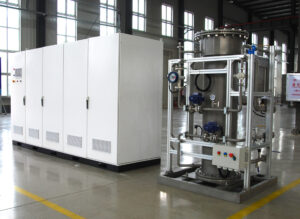En général, Les purificateurs d'eau stockent l'eau dans un réservoir de stockage d'eau après l'avoir purifiée et filtrée. En raison de la particularité du temps d'eau potable, Par exemple, L'eau traitée la nuit peut devoir être stockée dans le réservoir d'eau pendant la nuit avant de commencer le lendemain. Donc, Il y a un risque de croissance bactérienne, et une stérilisation supplémentaire et des étapes bactériostatiques sont nécessaires avant une utilisation sûre. À cet égard, La bactériostase d'ozone n'a pas été largement utilisée en raison de ses exigences techniques et d'équipement élevées, Mais il a été reconnu par l'industrie comme un coffre-fort, Méthode fiable et sans pollution.

Il y a deux façons pour l'ozone d'agir sur les polluants dans l'eau. L'un est une oxydation directe, c'est, Les molécules d'ozone interagissent directement avec les polluants dans l'eau. Dans ce processus, L'ozone peut oxyder une matière organique naturelle macromoléculaire dans l'eau, comme l'acide humique, acide fulvique, etc., et peut également oxyder certains polluants organiques volatils et certains polluants inorganiques, comme les ions de fer et de manganèse. L'oxydation directe est lente et a une certaine sélectivité, c'est, Les molécules d'ozone ne peuvent interagir qu'avec des polluants organiques ou des ions métalliques contenant des liaisons insaturées dans l'eau. Une autre façon est l'oxydation indirecte. L'ozone est partiellement décomposée pour produire des radicaux hydroxyles qui interagissent avec la matière organique dans l'eau. La réaction d'oxydation indirecte est très rapide, non sélectif, et peut réagir avec une variété de polluants.
La recherche montre que l'effet complet de la pré-oxydation de l'ozone sur la qualité de l'eau dépend d'une série de facteurs d'influence tels que le dosage de l'ozone, conditions d'oxydation, pH et alcalinité de l'eau brute, et les types et les concentrations de substances organiques et inorganiques coexistant dans l'eau. La pré-oxydation de l'ozone peut détruire les liaisons insaturées de la matière organique dans l'eau, réduire le poids moléculaire de la matière organique, et augmenter la concentration de la matière organique soluble Doc, spécifiquement manifesté comme une augmentation de la concentration de l'AOC et du BDOC, Amélioration ainsi la biodégradabilité de la matière organique. Cependant, L'expérience AMES, il montre que les produits intermédiaires partiellement oxydés ont une certaine activité mutagène, et il est nécessaire d'augmenter la dose d'ozone pour réduire l'activité toxique de ces produits. Pour les précurseurs de sous-produit de désinfection de chloration, La pré-oxydation de l'ozone peut la détruire dans une certaine mesure, ou le convertir en produits intermédiaires avec un potentiel de formation de sous-produits relativement faible.
L'eau brute est oxydée par l'ozone puis filtrée par du carbone activé. La matière organique macromoléculaire dans l'eau est oxydée et décomposée en petite matière organique moléculaire, qui est facilement absorbé par le carbone activé, Amélioration du taux d'extraction de la matière organique dans l'eau brute. En outre, L'ozone oxyde le Mn2 dans l'eau, ce qui en fait le MNO2 généré est adsorbé à la surface du carbone activé et retiré, Rendant ainsi l'effet de traitement de l'eau brute meilleur. Les groupes fonctionnels de surface et la structure des pores de l'ACF sont plus développés que l'OAC, Et il peut adsorber la matière organique et les macromolécules MN.
 générateur d'ozone maximum
générateur d'ozone maximum
